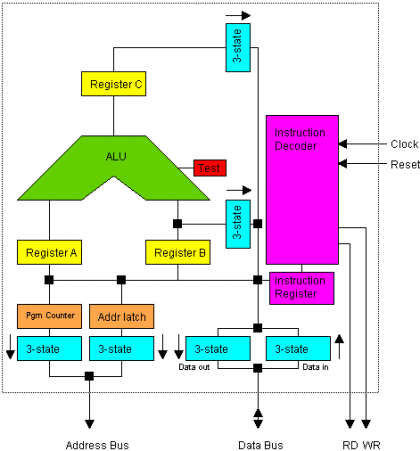
Inside
a Microprocessor
To understand how a microprocessor works, it is helpful to look inside and
learn about the logic used to create one. In the process you can also learn
about assembly language - the native language of a microprocessor - and
many of the things that engineers can do to boost the speed of a processor.
A microprocessor executes a collection of machine instructions
that tell the processor what to do. Based on the instructions, a
microprocessor does three basic things:
- Using its ALU (Arithmetic/Logic Unit), a microprocessor can
perform mathematical operations like addition, subtraction,
multiplication and division. Modern microprocessors contain
complete floating point processors that can perform extremely
sophisticated operations on large floating point numbers.
- A microprocessor can move data from one memory location to
another
- A microprocessor can make decisions and jump to a new set of
instructions based on those decisions.
There may be very
sophisticated things that a microprocessor does, but those are its
three basic activities. The following diagram shows an extremely
simple microprocessor capable of doing those three things:

This is about as simple as a microprocessor gets. This
microprocessor has:
- an address bus (that may be 8, 16 or 32 bits wide) that
sends an address to memory
- a data bus (that may be 8, 16 or 32 bits wide) that can
send data to memory or receive data from memory
- a RD (Read) and WR (Write) line to tell the
memory whether it wants to set or get the addressed location
- a clock line that lets a clock pulse sequence the processor
- A reset line that resets the program counter to zero (or
whatever) and restarts execution.
Let's assume that both
the address and data buses are 8 bits wide in this example.
Here are the components of this simple microprocessor:
- Registers A, B and C are simply latches made out of flip-flops (See the
section on "edge-triggered latches" in How Boolean Logic Works for details).
- The address latch is just like registers A, B and C.
- The program counter is a latch with the extra ability to
increment by 1 when told to do so, and also to reset to zero when
told to do so.
- The ALU could be as simple as an 8-bit adder (See the section on adders
in How Boolean Logic Works for details), or it might be able to add, subtract,
multiply and divide 8-bit values. Let's assume the latter here.
- The test register is a special latch that can hold values from
comparisons performed in the ALU. An ALU can normally compare two
numbers and determine if they are equal, if one is greater than
the other, etc. The test register can also normally hold a carry
bit from the last stage of the adder. It stores these values in
flip-flops and then the instruction decoder can use the values to
make decisions.
- There are 6 boxes marked "3-State" in the diagram. These are
tri-state buffers. A tri-state buffer can pass a 1, a 0 or
it can essentially disconnect its output (imagine a switch that
totally disconnects the output line from the wire the output is
heading toward). A tri-state buffer allows multiple outputs to
connect to a wire, but only one of them to actually drive a 1 or a
0 onto the line.
- The instruction register and instruction decoder are
responsible for controlling all of the other components.
Although they are not shown in this diagram, there would be control lines from
the instruction decoder that would:
- Tell the A register to latch the value currently on the data
bus.
- Tell the B register to latch the value currently on the data
bus.
- Tell the C register to latch the value currently on the data
bus.
- Tell the program counter register to latch the value currently
on the data bus.
- Tell the address register to latch the value currently on the
data bus.
- Tell the instruction register to latch the value currently on
the data bus.
- Tell the program counter to increment
- Tell the program counter to reset to zero
- Activate any of the 6 tri-state buffers (6 separate lines)
- Tell the ALU what operation to perform
- Tell the test register to latch the ALUs test bits
- Activate the RD line
- Activate the WR line
Coming into the instruction decoder are the bits from the test register and
the clock line, as well as the bits from the instruction register.


